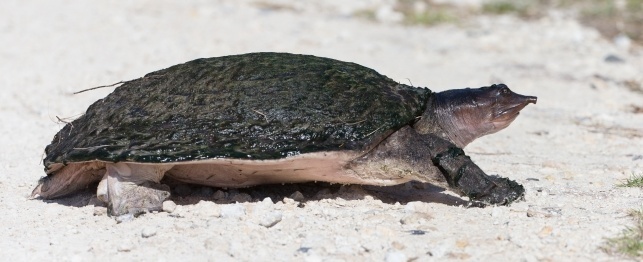

Reptiles
The soft-shelled turtle is a common pet turtle, named for the pliable edges of the leathery carapace (shell). These turtles are abundant and prolific, most commonly seen in rivers, but may also be seen in ponds and lakes. As with other turtles, it is illegal to sell soft-shells with a carapace length of less than 4 inches for pets. This is due to a regulation enacted in response to concerns about Salmonella and children.
Soft-shelled turtles can and will bite. The mandibles are sharp, the jaws powerful, and the neck long. Handle large ones only with extreme care. They can also scratch painfully if carelessly restrained.
Soft-shelled turtles are found in North America, Asia, Africa, and Malaysia. There are six subspecies of the spiny soft-shelled turtle found over most of the eastern half of the United States. Soft-shelled turtles have lived for more than 25 years.
Eastern soft-shelled turtles are quite cold tolerant and remain active rather late in the year. These turtles do not bask extensively. Instead, to thermoregulate, they come to the sun-warmed shallows, or may float at the surface of the water on sunny days. They often lie submerged in shallow water and may be buried shallowly in the river-bottom sand with only their head and neck showing. Soft-shells do occasionally bask on smooth sand or mud banks, but usually remain less than a shell length from the edge of the water. When suitably warm, the turtles either reenter the water, seek deeper and cooler water, or burrow more deeply into the river-bottom sand. They forage and breed while submerged. Food is found by sight, by scent, and perhaps, by touch. Females leave the water to lay their eggs.
Soft-shells are remarkably fast on land, and both fast and agile in the water. They are among the most enjoyable and graceful turtles to watch in any aquarium.
Females can be huge (close to 20 inches in carapace length) but males are usually 8 inches or less.
Both the hatchlings and the adults look like animated pancakes with a Jimmy Durante nose. They are not brilliantly colored at any time of their lives, but adult females are particularly poorly marked. Eastern soft-shells have tiny dark ocelli on the tan to olive-tan carapace and a single dark line that parallels the upper edge of the carapace. There are small spines on the front of the carapace, and the upper surface has a rough texture similar to sandpaper. There are dark-edged light lines on each side of the face. The snorkel-like nose is a trademark of most members of this family.
These moderate to large-sized turtles need space and very clean water in which to swim. A smooth, warmed, illuminated basking station is necessary. A suggested enclosure contains a substrate of a couple of inches of smooth desert or river-bottom sand. Sharp silica playsand is not recommended since it can cause irritation to the shell.
Up to a half dozen baby soft-shells can be housed temporarily in a properly appointed 10 or 15 gallon aquarium. The same number of 4-inch long specimens will require nothing less than a 30, and preferably a 40-gallon aquarium, and when fully grown will need a 75-gallon or larger tank. Where climates are moderate, these are excellent garden pool turtles.
Besides being filtered, the water in your turtle tank will require periodic changing. If you accomplish this by means of a siphon tube, do not start the siphon by sucking on it! Salmonella bacteria can be lurking! The more and larger your turtles, the more often the water will require changing. This holds true in a garden pond as well as in an indoor aquarium. A self-priming pond pump is an ideal way to remove the water from either indoor or outdoor units.
The best water temperature for these turtles is between 68 and 85 degrees Fahrenheit, but at the cooler temperatures a warmed basking area is imperative.
The daytime temperature should vary from 95 to 102 F. This can be provided by UV-B heatlamp bulbs used during the hours of daylight.
Soft-shelled turtles are basically carnivorous, eating earthworms, crickets, freshly killed minnows, tadpoles, pelleted trout chow, pelleted catfish chow, koi pellets, Reptomin and scientifically formulated turtle chows. Since uneaten animal protein based dietary items can quickly sour your water, feed these prudently.
Copyright © 2005-2016 Pet Information All Rights Reserved
Contact us: www162date@outlook.com